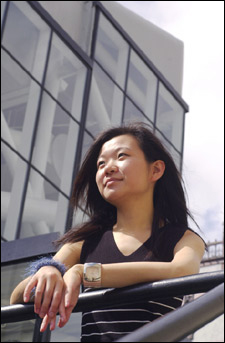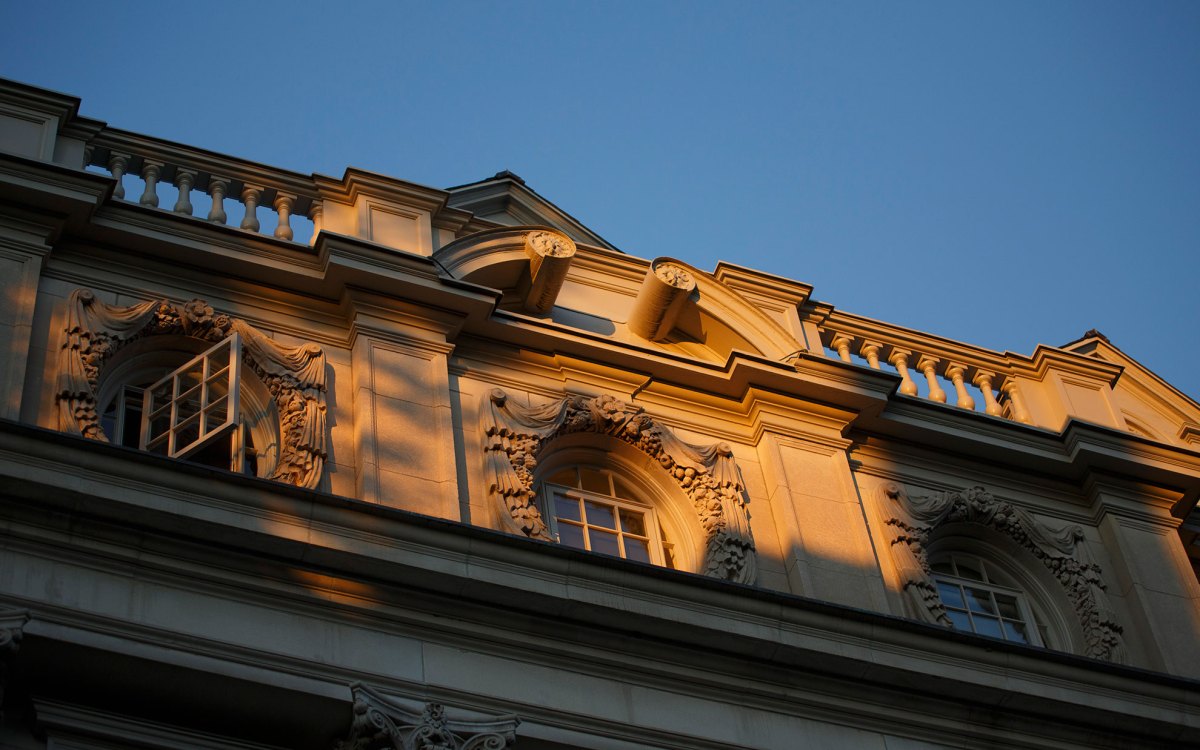Urban resuscitation:
GSD student Lin is part of team redesigning and revitalizing ancient Chinese city

Hundreds of years ago, Chinese architects designed a special city where the Ming emperors could rest on their way to visit their ancestral tombs.
This summer, Michelle Lin helped redesign it.
Lin, a fourth-year student at the Graduate School of Design (GSD) pursuing a dual degree in architecture and urban design, traveled to China this past August as part of an international team of design students. The group’s task was to come up with a development plan for the Gong Hua peninsula, formerly the emperor’s home away from home, now a neglected and abused landscape lying between two polluted rivers.
The group’s visit was sponsored by EDAW Inc., a large international planning and design firm, which has sponsored the summer intern program since 1980, sending students to a different location each year. This year, the program was nearly cancelled as a result of the SARS outbreak in China. Scheduled to travel to Beijing in June, the group spent the early part of the summer working in EDAW’s various branch offices, traveling to China after the SARS crisis ended.
The 15 students represented a variety of different nationalities and educational backgrounds. All spoke English, but for many it was a second language. Lin herself was one of several Mandarin speakers who took on translation duties once the group arrived in China. Born in Taiwan, she went to high school in southern California, then came to Harvard as an undergraduate, earning a degree in Visual and Environmental Studies in 2000.
It was Lin’s first visit to mainland China, and what she saw surprised her.
“It was more advanced than I thought it would be. Beijing was a much more international city than I expected. I was surprised by how many people understood English.”
Yet she found China to be very much a society in transition, in which many aspects of life exist on two levels: state-of-the-art, Western-style amenities for those who can afford them; the old, traditional ways for everyone else.
Despite differences in background, education, and outlook, the students soon developed a sense of camaraderie and found that they were able to work well together.
“It was definitely a great group to work with,” Lin said.
Their ability to cooperate and mesh their skills was fortunate, considering the task that faced them. In just two weeks they had to assess the site’s problems, gather information, formulate solutions, and put together a presentation. They had help from EDAW personnel and from Chinese experts, but the final ideas were their own.
The site consists of a long, narrow, low-lying piece of land between two rivers, about an hour’s drive north of Beijing. The city that once housed the Ming emperors has been largely destroyed, its stones salvaged by local farmers to build their houses. Lacking paved roads, sewers, and other amenities, the peninsula is home to about 13,000 residents, many of them unskilled agricultural workers who have been left behind by China’s rapid modernization.
Ironically, just across the river from the Gong Hua peninsula is Green Rivers Manor, one of several upscale developments modeled on American luxury housing and designed to appeal to a wealthy Chinese minority.
“For me it was horrifying,” said Lin. “I don’t believe it’s very ethical. It’s a gated community that excludes everyone who is not wealthy. It’s like a little Disneyland. It doesn’t take into account anything about Chinese culture.”
The group’s Chinese hosts were in agreement with Lin’s assessment. During the information-gathering phase of their visit, the students were exposed to more typically Chinese design solutions. Other experiences on their itinerary were of a purely cultural nature, including visits to the Forbidden City and the Summer Palace and a candlelight dinner atop the Great Wall.
After a week of lectures and site visits, the group was ready to begin formulating their plans. The design they came up with calls for the existing population to be relocated to temporary housing on the west side of the peninsula during the construction of a new town center. The four gates of the emperor’s original walled city will remain standing, but within the perimeter the students proposed building an assortment of single-family houses, town houses, and high-rise apartments.
A central corridor will cut through the town, following a curving path to preserve the existing large trees. The students recommended against developing the wetlands at the tip of the peninsula, but rather suggested leaving it intact and installing technology to clean the polluted water.
Will the Chinese authorities adopt the students’ suggestions? There is no guarantee, but Lin believes that “some ideas here and there will be useful.”
Of equal if not greater importance is what the experience has done for her education. Originally, Lin chose the difficult and time-consuming option of a dual degree because she felt that architecture by itself did not give her an opportunity to develop the full range of her interests.
“I like architecture, but I enjoy knowing about other aspects of society – economics, politics. Urban design is a way of addressing those issues. But before I did this internship, I had no idea of what urban designers do. Now I feel much more sure that I’ve made the right choice.”
She also feels more attracted to the idea of returning to East Asia, either to mainland China or Taiwan, and using her skills to contribute to the development of those countries.
“China is changing so fast. There’s a lot of potential for work and for creativity. I’m definitely thinking of going back.”




